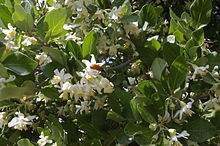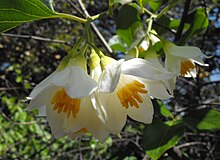Real storax tree
| Real storax tree | ||||||||||||
|---|---|---|---|---|---|---|---|---|---|---|---|---|

Real storax tree ( Styrax officinalis ) |
||||||||||||
| Systematics | ||||||||||||
|
||||||||||||
| Scientific name | ||||||||||||
| Styrax officinalis | ||||||||||||
| L. |
The True Storaxbaum or True Styraxbaum ( Styrax officinalis ) is a shrub or small tree of the family of styracaceae (Styracaceae). The twigs are initially tomentose, the leaves are downy-haired. The white, fragrant flowers are about 2 inches long. Its resin is used for incense and perfumes, but also medicinally, and rosaries are made from the fruit.
description
The real storax tree is a deciduous, up to 7 meters high, broadly upright shrub or small tree with thin and initially felty, star-haired branches. The leaves are arranged alternately. The leaf blade is ovate, 4 to 6 centimeters long, with entire margins and initially hairy with white fluff. The underside of the leaf is gray-green.
The 1 to 2 centimeters long, stalked, about 2 centimeters long and fragrant flowers grow in groups of three to eight in pendulous, terminal clusters on short shoots . The calyx is cup-shaped, with almost entire margins or serrated five to seven times. The corolla tube is very short, the five to seven corolla lobes are white, densely haired and narrow-lanceolate. The fruits are spherical, about 1 centimeter thick, leathery and woolly with a preserved calyx. The real storax tree blooms in April and May.
Distribution and location requirements
The natural range is in Europe in Italy, on the Balkan Peninsula , in Greece and on Crete and Cyprus; in Asia in Israel, Jordan , Syria and Turkey. The species was naturalized in southern France. She is the only representative of the family in the Mediterranean area. The real storax tree grows in light forests, in bushes and on river banks on dry to fresh, weakly acidic to strongly alkaline, sandy, sandy-gravelly or sandy-loamy nutrient-rich soils in sunny and hot locations. The species is sensitive to frost and moisture. The distribution area is assigned to winter hardiness zone 9 with mean annual minimum temperatures of −6.6 to −1.2 ° C (+20 to +30 ° F ).
Systematics
The real storax tree ( Styrax officinalis ) is a species from the genus of the storax trees ( Styrax ) in the family of the storax trees (Styracaceae). It was first scientifically described by Carl von Linné in the Species Plantarum in 1753 . The generic name Styrax was used for the species even before Linnaeus and was also used by the Romans and Greeks . The specific epithet officinalis is a neo-Latin expression that was not used until Linnaeus' time and corresponds to the German expression " offizinell ".
use
The resin supposedly obtained from the branches and trunks in earlier times is said to have a strong scent. It is said to have an antiseptic and expectorant effect and is said to have been used as a spice and for the production of perfumes and incense . This supposed styrax resin is no longer available nowadays, but it is possible that it was produced from certain phenotypes or populations or under certain environmental conditions. Rosaries are made from the fruits . The real storax tree is sometimes planted as an ornamental shrub because of its decorative flowers .
swell
literature
- Andreas Roloff , Andreas Bärtels: Flora of the woods. Purpose, properties and use. With a winter key from Bernd Schulz. 3rd, corrected edition. Eugen Ulmer, Stuttgart (Hohenheim) 2008, ISBN 978-3-8001-5614-6 , p. 634.
- Ingrid Schönfelder, Peter Schönfelder : The cosmos Mediterranean flora . 3. Edition. Franckh, Stuttgart 1999, ISBN 3-440-07803-5 , pp. 178-179 .
- Helmut Genaust: Etymological dictionary of botanical plant names. 3rd, completely revised and expanded edition. Nikol, Hamburg 2005, ISBN 3-937872-16-7 , pp. 432, 617 (reprint from 1996).
Individual evidence
- ↑ German name after Roloff et al .: Flora der Gehölze , p. 634.
- ↑ German name after Schönfelder et al .: Die Kosmos-Mediterranflora , p. 178.
- ↑ a b c d Roloff et al .: Flora der Gehölze , p. 634.
- ↑ a b c d Schönfelder et al .: Die Kosmos-Mediterraneanflora , p. 178.
- ↑ a b Styrax officinalis . In: Germplasm Resources Information Network (GRIN). United States Department of Agriculture, accessed November 1, 2012 .
- ↑ Exactly: Etymological Dictionary of Botanical Plant Names , p. 617.
- ↑ Exactly: Etymological Dictionary of Botanical Plant Names , p. 432.
- ↑ Does Styrax officinalis L. provide a resin? (PDF; 2.87 MB), from e-periodica.ch, accessed on January 1, 2017.
- ^ Paul T. Nicholson, Ian Shaw: Ancient Egyptian Materials and Technology. Cambridge University Press, 2000, ISBN 0-521-45257-0 , p. 437.
- ↑ Jehuda Feliks: Storax. In: Fred Skolnik, Michael Berenbaum: Encyclopaedia Judaica , Vol. 19, 2nd Edition, 2007, Thomson Gale, ISBN 978-0-02-865928-2 , p. 238, online .
- ^ Jean H. Langenheim: Plant Resins. Timber Press, 2003, ISBN 978-0-8819-2574-6 , pp. 354 f. online (PDF; 22.18 MB).
- ↑ Styrax officinalis at Plants For A Future . Retrieved November 1, 2012.
Web links
- Styrax officinalis L. (Styracaceae). Institute for Plant Sciences, Karl-Franzens-University Graz,accessed on November 1, 2012(photos).


